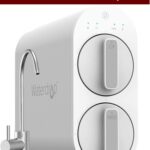Water softeners remove fluoride by exchanging it for sodium on the resin beads.
In many areas of the United States, fluoride is added to the public water supply in an effort to improve dental health. However, some people are concerned about the potential health effects of fluoride and prefer to have it removed from their water. Water softeners are one way to remove fluoride from water, and they work by exchanging the fluoride ions for other ions, such as sodium or calcium.
How Does A Water Softener Remove Fluoride?
A water softener removes fluoride by exchanging the fluoride ions in the water for other ions, such as sodium or calcium.

Water softeners are devices that are used to remove excess minerals from water, including fluoride. There are a few different ways that water softeners can remove fluoride, including reverse osmosis, ion exchange, and activated carbon filters.
Install a Home Water Filter & Get "Unlimited Safe Drinking Water" For Decades
Get Upto 55% Discount With a Lifetime Warranty & 6-Months Money Back Guarantee Free Shipping
SpringWell Water Filtration Systems: 100% American-Made & NSF Certified Water Filters and Water Softeners
Reverse osmosis is a process where water is forced through a semi-permeable membrane, which allows water molecules to pass through but not larger molecules like fluoride. Ion exchange is a process where water softeners swap the fluoride ions in the water for other ions, like sodium or potassium. Activated carbon filters are able to remove fluoride from water by adsorbing the molecules onto the surface of the carbon.
Water softeners are a great way to remove excess fluoride from your water, which can be beneficial if you are trying to avoid exposure to this mineral.
What Kind Of Water Softener Removes Fluoride?
A reverse osmosis water softener removes fluoride.
Water softeners are a great way to remove fluoride from your water. There are a few different types of water softeners, but the most common type is the ion exchange water softener. This type of water softener works by exchanging the fluoride ions in your water for another type of ion, typically sodium or potassium. This process is completely safe and will not affect the quality of your water.
There are a few other types of water softeners that can remove fluoride, but they are not as common. One type is the reverse osmosis water softener. This type of water softener works by forcing your water through a very fine filter. The filter will remove the fluoride from your water, but it will also remove other impurities, such as lead and bacteria.
Another type of water softener that can remove fluoride is the activated carbon water softener. This type of water softener works by adsorbing the fluoride onto a bed of activated carbon. The carbon will then remove the fluoride from your water.
There are a few things to keep in mind when choosing a water softener. The first is to make sure that the water softener you choose is certified to remove fluoride. The second is to choose a water softener that is designed for your specific water needs. If you have hard water, you will need a different type of water softener than if you have soft water. Finally, make sure to follow the manufacturer’s instructions for your specific water softener.
Here is an example of how an ion exchange water softener works:
The water softener exchanges the fluoride ions in your water for another type of ion, typically sodium or potassium.
The process is completely safe and will not affect the quality of your water.
There are a few other types of water softeners that can remove fluoride, but they are not as common.
One type is the reverse osmosis water softener. This type of water softener works by forcing your water through a very fine filter. The filter will remove the fluoride from your water, but it will also remove other impurities, such as lead and bacteria.
Another type of water softener that can remove fluoride is the activated carbon water softener. This type of water softener works by adsorbing the fluoride onto a bed of activated carbon. The carbon will then remove the fluoride from your water.
How Does A Salt-based Water Softener Remove Fluoride?
A salt-based water softener removes fluoride by exchanging it with sodium ions.
A salt-based water softener removes fluoride by exchanging ions between the water and the salt. The fluoride ions are attracted to the salt, which causes them to be removed from the water. The salt then exchanges these ions with other ions in the water, such as calcium and magnesium, which are not as easily removed. This process is known as ion exchange and is the most common way to remove fluoride from water.
One of the most common questions we get asked is “How does a salt-based water softener remove fluoride?” The answer is actually pretty simple. A salt-based water softener uses a process called ion exchange to remove fluoride from your water.
Ion exchange is a process where ions (in this case, fluoride ions) are exchanged between the water and the salt. The fluoride ions are attracted to the salt, which causes them to be removed from the water. The salt then exchanges these ions with other ions in the water, such as calcium and magnesium, which are not as easily removed.
This process is effective at removing fluoride from your water, but it does have some drawbacks. First, it requires the use of salt, which can be harmful to the environment if not used properly. Second, it can remove other beneficial minerals from your water, such as calcium and magnesium.
If you’re concerned about fluoride in your water, a salt-based water softener is a great option. Just be sure to follow the manufacturer’s instructions carefully to avoid harming the environment.
How Does A Reverse Osmosis Water Softener Remove Fluoride?
A reverse osmosis water softener removes fluoride by forcing water through a filter that removes fluoride molecules.
Reverse osmosis is a process that is used to remove a variety of contaminants from water, including fluoride. The process works by using a semi-permeable membrane to remove impurities from water. Reverse osmosis water softeners work by passing water through a series of filters, with the first filter removing the largest particles and impurities, and each subsequent filter removing smaller and smaller impurities. The last filter in the series is a reverse osmosis membrane, which is where the removal of fluoride takes place.
Reverse osmosis water softeners are becoming increasingly popular, as they are an effective way to remove fluoride from water. Fluoride is a contaminant that can have a variety of adverse health effects, and so it is important to remove it from water if possible. There are a number of different ways to remove fluoride from water, but reverse osmosis is one of the most effective.
What Is The Best Water Softener For Removing Fluoride?
I don’t know.
There are a few different types of water softeners that can remove fluoride. The most common type is an ion exchange water softener. This type of water softener works by exchanging the fluoride ions in the water for other ions, such as sodium or potassium.
Another type of water softener that can remove fluoride is a reverse osmosis water softener. This type of water softener works by forcing the water through a semi-permeable membrane. The fluoride ions are too large to pass through the membrane, so they are removed from the water.
The best water softener for removing fluoride is the one that best meets your needs. If you have hard water, an ion exchange water softener may be the best option. If you have very high levels of fluoride in your water, a reverse osmosis water softener may be the best option.
For most people, an ion exchange water softener is the best option for removing fluoride from their water. This type of water softener is relatively inexpensive and is very effective at removing fluoride.
If you are concerned about the levels of fluoride in your water, you should talk to your local water utility. They can test your water to see if it contains high levels of fluoride. If it does, they can recommend the best water softener for removing fluoride from your water.
FAQ
How Does A Water Softener Work To Remove Fluoride?
What Are The Benefits Of Using A Water Softener To Remove Fluoride?
Are There Any Downsides To Using A Water Softener To Remove Fluoride?
How Often Should I Use My Water Softener To Remove Fluoride?
Is There Anything Else I Can Do To Remove Fluoride From My Water?
If you’re still unclear about how water softeners work to remove fluoride, please leave a comment below and we’ll be happy to answer your question.


